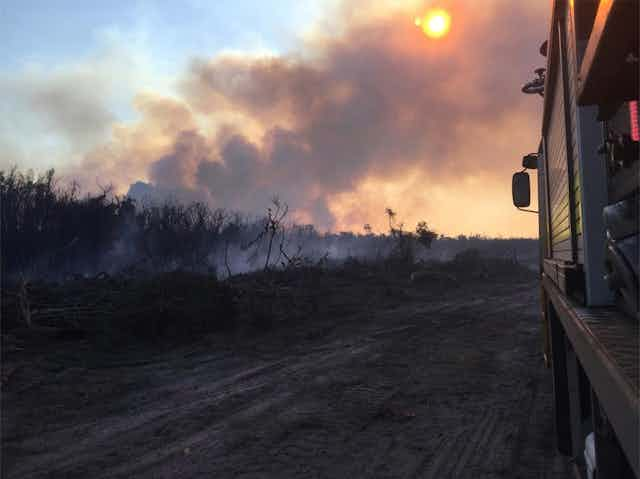Last week catastrophic fires killed four people in Esperance, Western Australia. How these people died remains under investigation, although reports suggest that one man, a local farmer, died while warning neighbours of the fire danger.
Three other people, one male and two female foreign nationals, were reportedly working on a local farm and died while attempting to save a horse.
All four deaths occurred in or close to vehicles. Four homes are reported to have been destroyed.
According to our database at Risk Frontiers, there have now been 29 deaths from bushfires in Western Australia since 1925. Bushfires are not the biggest killer - cyclones have killed more people - however our data reveal that bushfire deaths are increasing, particularly for females and people deciding to leave their homes in the last minute.
Who dies in fires?
The chart below shows the 29 people killed in bushfires in WA since 1900. Of this total, 22 were men and 7 women. While fatalities are common among young males, a number of older male fatalities have died from heart attacks and exhaustion.
Prior events in which three or more were killed occurred in:
1958 when four forestry workers perished while making a fire break,
2003 when two females were killed while fleeing the fire and one firefighter was killed when his tanker was involved in a road accident, and
2007 when one female died fleeing the bushfires and three men were killed when bushfires engulfed their truck convoy
The chart below shows the actions at the time of death for fatalities prior to 2015. The majority of male deaths, and deaths overall, occurred while the victims were engaged in defensive duties outside on farms or on official fire-fighting duties. Most women were killed fleeing fires.
The majority of men were aware of the fire carrying out premeditated defensive duties. Three females were killed who either did not have a plan or were not following it and evacuated late.
The first female fatality occurred in 1997 and this was also the first bushfire fatality in WA where the deceased had not been actively defending property outside or on official fire-fighting duties. Since 1997 many of the deaths have been those in vehicles either unaware of the danger or engaged in late evacuations.
The circumstances of the recent deaths remain under investigation, however it seems that they were aware of the fires and had enough time to save their lives but their evacuations were delayed trying to assist neighbours and livestock. Three of the deaths have been confirmed as foreign nationals and this raises questions about whether we are doing enough to inform and educate tourists and temporary workers about bushfire risks.
Importantly there have been no fatalities in WA where people have been sheltering within homes or other structures, and this remains the safer option rather than late evacuation if bushfires have already arrived.
Risk Frontiers, with CSIRO and RMIT University is currently investigating the experiences of over 300 people who sheltered during the Black Saturday bushfires. The aim is to inform policy and practice around sheltering in situations when defence fails and/or it is too late to evacuate.
Putting bushfire deaths in context
Risk Frontiers is also funded by the Bushfire and Natural Hazard CRC to investigate the social and environmental circumstances of deaths from the full range of natural hazards in Australia.
These numbers are undergoing revision as more deaths are uncovered and records are verified with coronial inquest data, however, the table below shows that to date tropical cyclones have killed more people in WA than all the other perils combined.
The majority of these deaths occurred in two events in 1912 (149 fatalities) and 1935 (140 fatalities). The largest recent event occurred in 1991 with 29 fatalities. Unlike all the other hazards, stringent building code changes over the last 30 – 40 years have significantly reduced the risks posed by cyclones.
Measuring and understanding the impacts of natural hazards in terms of the toll of human life is a fundamental first step to enabling efficient and strategic risk reduction. This must include a longitudinal analysis of the social and environmental circumstances that led to fatalities in order to examine trends over time in terms of exposure and vulnerability.
Only then can we interpret these trends in the context of emerging issues (e.g. ageing population and population shifts, building codes etc), and how these issues might influence future vulnerability and exposure trends.
In WA emergency management policy and practice must consider how to reduce causalities from late evacuation, particularly women and foreign nationals.

